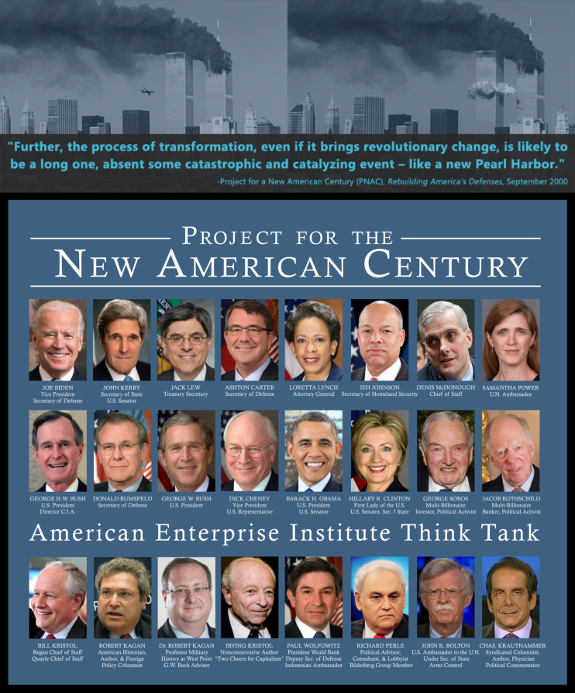The 1992-issued Defense Planning Guidance Memorandum, also known as the Wolfowitz Doctrine.
The document’s central/ principal strategy/ guideline was seen to be the establishment and the protection of a new order and the maintenance of mechanisms capable of deterring potential competitors from aspiring to a more influential/ prominent role in transnational and globally-centric dynamics. Numerous scenarios governing the preservation of U.S. interests on an international scale concern the incidence of regional-based conflicts capable of compromising access to vital raw materials, primarily Persian Gulf oil reserves; or those which serve to aid in the proliferation of weapons of mass destruction. Examples of possible combat related/ conflict generating areas outlined within the purlieus of the DPG document included North Korea, Iran, and Iraq; the latter having recently suffered defeat in the Gulf War, yet with Saddam’s regime left intact. If necessary, the DPG documentation stated, the United States should be authorized to act in a pre-emptive and unilateral measure to preserve American interests abroad and to secure a measure of military superiority across the global spectrum. The notion of utilizing combat-oriented tactical offensives as a measure of deterrence as pretext for the fulfillment of foreign policy objectives in various regions of the world was clarified in several statements made by retired US Army General Wesley Clark, an individual also recognized as the former Supreme Allied Commander Europe (SACEUR) of NATO and later a one-time presidential candidate operating under the auspices of the Democratic National Committee (DNC):
The decorated serviceman would later reiterate these contentions during the course of a public speaking engagement at the Commonwealth Club of California in the city of San Francisco on October 3rd of 2007.
In 1997, along with then Florida governor Jeb Bush (George W. Bush’s brother), former and future Secretary of Defense Donald Rumsfeld and other prominent neoconservatives, Wolfowitz and Cheney signed the Statement of Principles into a formative legislative mandate under the newly structured PNAC. Reminiscent of events associated with the Reagan administrative era, the statement mentioned the necessity of a “new century favorable to American principles and interests” interdependent on the presence of four prerequisite politically-based dynamics:
1) A marked increase in monetary expenditure relative to national defense spending in an effort to facilitate the modernization of military forces and to ensure an armed presence on domestic fronts.
2) The strengthening of international bonds with democratic allies and the confrontation and challenge of regimes perceived as being hostile to the interests and values of America’s political establishment.
3) The promotion of the cause of political and economic freedoms abroad.
4) The acceptance of responsibility pursuant to U.S. role in the preservation and extension of an international order (The New World Order) sympathetic to overall national security concerns and essentialities, corporate level prosperity relevant to the prospect of future arms races with rogue nations intrinsically formulated/ designed to facilitate the genesis and continued presence of a military industrial complex, and to the principles ascribed to the nation as a whole.
The Establishment of the Project for the New American Century and Its Connection to the Terrorist Attacks of September 11, 2001

Numerous theories regarding the tragic sequence of events that occurred on September 11th of 2001 have been proffered, many of which skeptics have sought to prove have no basis in reality. The release of the ‘Rebuilding America’s Defenses’ document in 2000 (A 90 page dissertation published during the height of political debates focused on the controversy surrounding the protracted War in Iraq, that, coincidentally, was also formulated prior to the aforementioned trespass), specifically written contents ascribed to Section V ’Creating Tomorrow’s Dominant Force,’ where passages emphasizing a hastening in the transformation of America’s armed forces through the introduction of ‘new technologies and operational concepts’ through “some catalyzing or catastrophic event – like a new Pearl Harbor” were later called into question.
‘Rebuilding America’s Defenses’ | Strategy, Forces and Resources For a New Century - September 2000 Publication
Author, syndicated columnist, and investigative journalist John Pilger would later suggest that the Bush Administration used the September 11 tragedy as an opportunity to capitalize on the development of a comprehensive strategy designed to bolster America’s offensive capabilities. Citing the possibility of an globally orchestrated American hegemony in an article published in Der Spiegel in 2003, Jochen Bölsche claimed that Rebuilding America’s Defenses “had been developed by PNAC for Rumsfeld, Cheney, Wolfowitz and Libby,” and was “devoted to matters of ‘maintaining US pre-eminence, thwarting rival powers and shaping the global security system according to U.S. interests.’” Similar allegations were made in 2003 by British MP (Member of Parliament) Michael Hugh Meacher in statements that insinuated that the Rebuilding America’s Defenses document was crafted as a “blueprint for the creation of a global Pax Americana ¹,” which had been “drawn up for” key members of the Bush Administration. Bush’s ties to the energy sector, paired with acting Vice President Dick Cheney’s association with military defense contracting agencies, further substantiated these contentions as it was later revealed that elements present within the upper echelons of the 43rd President’s cabinet willfully disregarded a Daily Brief prepared by the Central Intelligence Agency on August 6, 2001 that warned of the possibility of foreign national terrorist offensives being levied against the United States 36 days prior to 9/11. A document that was later made public in April 10 of 2004:
Declassified August 6, 2001 President’s Daily Briefing (PDB)
In the months that followed, during the course of open testimony before members of the 9/11 Commission, acting U.S. Secretary of State Condoleeza Rice sought to dispel the notion of the Federal Government’s foreknowledge of the possibility of a terrorist attack, stating that the CIA’s PDB did not warn of a new existential threat but rather was a reflection of “historical information based on old reporting.” The general public was led to believe that this was the only issuance of a precautionary statement regarding the potential for incident, only to be informed later through the release of a report detailing the fact that high ranking members of the FAA (Federal Aviation Administration) had indeed received 52 separate and distinct warnings of a plot involving the use of conventional passenger planes or commercial jet airliners in a coordinated tactical offensive designed to inflict mass casualty and destabilize America’s financial infrastructure.
¹ A term whose Latin equivalent is recognized as “American Peace,” adopted from the phrases Pax Britannica and Pax Romana, is a concept applicable to the continuance of peace and regional stability in the Western Hemisphere of the world through a concentration of power and influence in the United States.
CONCLUSION: Numerous legislative policies enacted by the PNAC have purportedly faded into the shadows of an irrepressible antiquity, yet, despite the fact that such tenets have seemingly undergone a perpetual nullification, protocol relevant to the organization’s principal foundation has only to be awakened by future government administrations seeking to promote the establishment of a globalized geopolitical order.
































0 comments:
Speak your mind and let your voice be heard.
This is a censorship free discussion area, however, any comments that deviate from the content presented on this site will be subject to removal without notice.